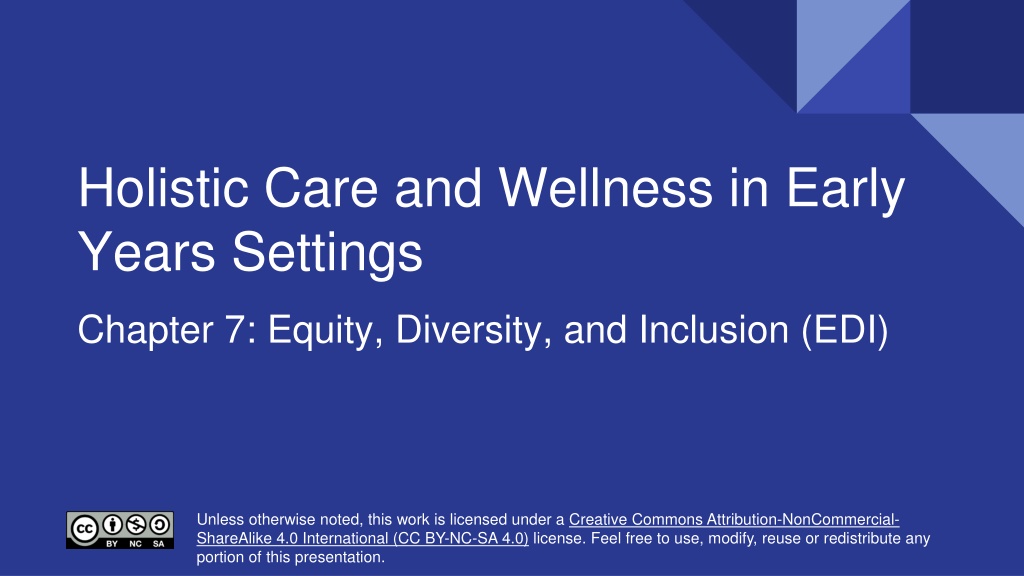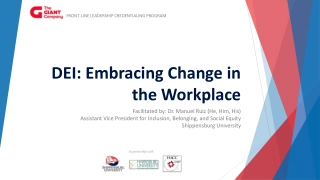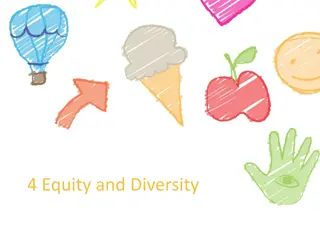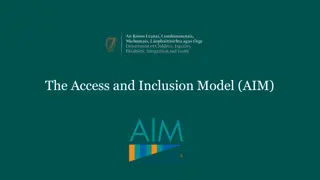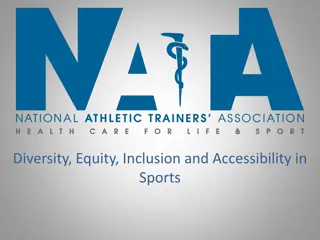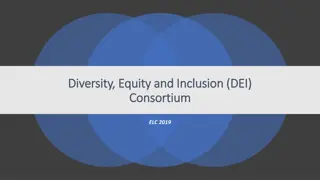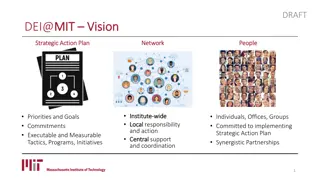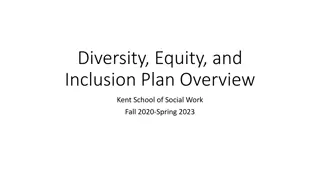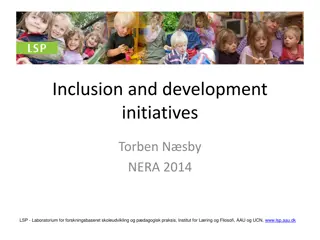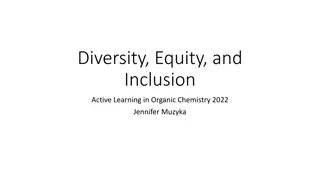Promoting Equity, Diversity, and Inclusion in Early Years Settings
Establishing inclusive environments, understanding biases, and fostering respect are key in promoting equity, diversity, and inclusion in early childhood education. Educators play a vital role in creating spaces that support diverse learners and families, addressing systemic issues, and cultivating a sense of belonging for all children. Through self-reflection, ongoing learning, and community engagement, early years settings can become equitable and inclusive spaces for children and families to thrive.
Download Presentation

Please find below an Image/Link to download the presentation.
The content on the website is provided AS IS for your information and personal use only. It may not be sold, licensed, or shared on other websites without obtaining consent from the author. Download presentation by click this link. If you encounter any issues during the download, it is possible that the publisher has removed the file from their server.
E N D
Presentation Transcript
Holistic Care and Wellness in Early Years Settings Chapter 7: Equity, Diversity, and Inclusion (EDI) Unless otherwise noted, this work is licensed under a Creative Commons Attribution-NonCommercial- ShareAlike 4.0 International (CC BY-NC-SA 4.0) license. Feel free to use, modify, reuse or redistribute any portion of this presentation.
Learning Outcomes In this chapter, we will: Establish and maintain inclusive early years environments that support diverse, equitable and accessible learning opportunities for children and their families. Develop an understanding of accountable spaces for an equitable, diverse, and inclusive practice for educators working in the early years. Develop an understanding of barriers children, families, and communities encounter when accessing early years supports.
7.1 Equity, Diversity, and Inclusion (EDI) Equity, diversity, and inclusion (EDI) are vital in early years settings due to diverse children and families. Families seek community, growth, or practical support from early learning services. Educators cultivate EDI by learning, reflecting, and respecting diverse worldviews. Building relationships with families and co-workers fosters an inclusive learning environment. Photo by Meruyert Gonullu, Pexels License.
7.2 Worldviews Social location shapes our worldviews, including factors like age, culture, gender, etc. Educators reflect on their social location's impact on their worldview and learning space engagement. Ongoing professional learning fosters self-awareness and openness to new ideas. Knowledge of history and systemic issues informs work with children and families, addressing racism and biases in Canada. Social location is important because it strongly influences our identity, or our sense of self, and how we see the world (SVTDT, 2019).
7.3 Understanding Bias in Professional Practice As educators become more familiar with their social location and worldviews through self- reflection, they begin to understand their biases as individuals. Everyone has biases based on their lens or worldview. Educators work to acknowledge and disrupt these biases in their work with children, families, and each other. This ongoing practice supports educators in building trusting, respectful and professional relationships with others. All children have the right to a holistic sense of well-being, to express themselves, to feel a sense of belonging, and to be included in an equitable and diverse early years setting. Educators set the stage for this environment in partnership with families through support from the community where they are located.
7.4 Equity in Early Years Settings As discussed in chapter one, How Does Learning Happen: Ontario s Pedagogy for the Early Years and The Kindergarten Program provide educators in the early years with excellent resources to support building the foundation for a sense of belonging and well-being for all children in their care. The six ELECT principles can be found on page 10 in How Does Learning Happen? to enhance the four foundations necessary for equitable learning spaces in the early years. Photo by Tim Mossholder, Unsplash License.
7.4 ELECT Principles Principle 1: Positive experiences in early childhood set the foundation for lifelong learning, behaviour, health, and well-being. Principle 2: Partnerships with families and communities are essential. Principle 3: Respect for diversity, equity, and inclusion is vital. Principle 4: An intentional, planned program supports learning. Principle 5: Play and inquiry are learning approaches that capitalize on children s natural curiosity and exuberance. Principle 6: Knowledgeable, responsive, and reflective educators are essential.
7.5 Diversity in Early Years Settings Educators embrace diverse worldviews for enriching the early years learning space. Inclusion and belonging are fostered when everyone can see themselves represented in the space. Culturally responsive teaching (CRT) respects and includes cultural traditions and knowledge. Educators have a role in guiding children's respect and care for diverse perspectives. Early years settings embed anti-bias principles in policies and procedures. Ongoing communities of practice support educators' professional growth in anti-biased approaches. Photo by Pavel Danilyuk, Pexels License.
7.6 Inclusion in Early Years Settings I What is inclusion? Inclusion is a universal human right and its objective is to accept, welcome and embrace all people irrespective of race, gender, disability, medical or other need. Inclusion consists of the efforts and practices to ensure groups or individuals with different backgrounds are culturally and socially accepted, and treated equally (Inclusion Action in Ontario, 2022, para.1). Ontario's early years settings collaborate with professionals for inclusive education and care. Resource consultants connect families and educators with additional support services. Individualized Support Plans are developed to ensure inclusive practices. Photo by falco, Pixabay License.
7.6 Inclusion in Early Years Settings II Individualized Family Service Plan (IFSP): IFSPs involve collaboration among early years setting, family, resource consultant, and professionals. IFSP addresses child and family needs, including goals and service updates. Educators attend IFSP meetings to share insights, fostering relationships and ensuring child's care aligns with plan. Educators implement assistive devices and work with an interprofessional team for inclusive early years care. Individualized Support Plan (ISP): Families who do not want to be involved in the development of an Individualized Family Service Plan can aid in the development of an Individualized Support Plan (ISP) with an early years setting. Licensees can develop an ISP jointly with the family in order to better understand how to prepare the setting for the child to ensure they are fully included in the program.
7.7 Accountable Spaces Educators are tasked with creating safe spaces for children, families, and colleagues to share their diverse perspectives. As discussed earlier in this text, creating safe physical spaces is important for children, while allowing for manageable risk-taking to increase confidence and positive self-esteem. Creating spaces that embrace differences in a manner that supports a sense of belonging and well-being has been mentioned multiple times. As noted in the important work by Elise Ahenkorah we cannot guarantee that we will provide a safe space for everyone. As educators we continue to learn more about our accountabilities to those entrusted to our care. While we often think of our roles as focused primarily on accountabilities to children we also need to consider their families, our colleagues, and the communities in which we work. Ongoing learning and communities of practice help guide our practice and continued growth in such an important role. Many resources are available locally to support knowledge building through Strive, All Kids Belong, AECEO, OCBCC, PEACE, CYN, LCCN, CCCF, and many more. These resources will be shared in chapter eight.
7.8 Barriers to Access Many families in Canada face barriers accessing early years settings due to remote locations and transportation issues. London, Ontario has been ranked low in providing licensed childcare and faces accessibility challenges. The Canada Wide Early Learning and Child Care (CWELCC) plan reduces childcare fees, increasing demand and causing waiting lists in early years settings. Shortage of qualified educators and infrastructure issues hinder the growth of licensed childcare agencies. Collaboration between government levels aims to improve workforce conditions and address infrastructure challenges to expand the early years system. Photo by Daniel Ali, Unsplash License.
7.8 Barriers Impacting Wellness in the Early Years Many families face barriers in accessing early years settings that meet their needs and the needs of their children. These barriers are extensive and varied, including accessibility, inclusivity, affordability, and responsiveness. When a family cannot access the support of an early years setting of their choosing they are forced to remain out of the workforce, to access programs that are not culturally relevant, or to use alternative arrangements that are not their preferred choice.
7.8 Barriers to Inclusion Limited resources in early years settings, including funding and human resources, impact equitable and inclusive care. Partnerships between settings and agencies supporting inclusive services are hindered by insufficient funding, affecting support availability. Inadequate funding and training can hinder programs from providing services for children with special needs. "How Does Learning Happen?" outlines program expectations; ongoing professional development helps educators meet these expectations. Accessibility standards and policies are mandatory for all Ontario organizations; funding can be sought to make spaces accessible. Ministry of Education and agency consultants collaborate to ensure accessible services through assessment and universal design for learning. Photo by Karl Fredrickson, Unsplash License.
7.8 Barriers to Affordability Despite affordable childcare under CWELCC, many families can't afford the reduced fees and rely on food banks due to financial struggles. Childcare fee subsidies are limited, leaving families without income support struggling to find childcare between training programs or during job searches. Newcomers to Canada may lack awareness of available financial support services, making early years settings crucial for sharing resources. Family Centres and Early ON programs partner with public health units to provide additional support and resources to families. Educators play a crucial role in establishing trust and awareness, being the first point of contact for families facing housing challenges. Photo by U.S. Department of Agriculture, CC BY 2.0.
7.8 Barriers to Access Lack of awareness of culturally responsive teaching creates barriers for children and families in early years settings. Early years settings play a vital role in fostering a sense of belonging and well-being, especially for newcomers and those seeking cultural connections. Educators' participation in co-constructing knowledge is hindered by time constraints, affecting collaborative efforts. Resources within early years settings facilitate employee engagement and learning. Open communication with families fosters trust and responsive relationships, promoting a strong sense of belonging and well- being. Responsive education and care in early years contribute to the development of future citizens with a sense of belonging. Photo by Kampus Productions, Pexels License.
